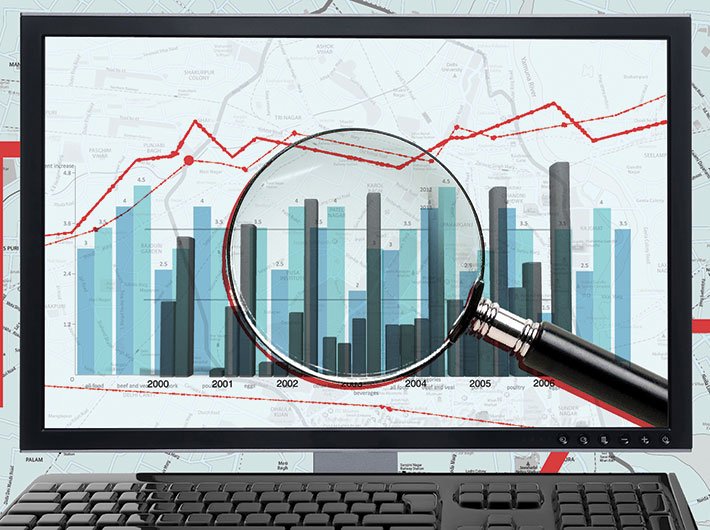Measure, analyse, predict – MAP for short – can be an effective guiding principle of new governance
Earlier in this column, I had discussed what governments can learn from businesses and vice versa. This piece is not about that per se. But yes, there is a definite shift in expectation from technology in business. And it is time that happened in the realm of governance too.
The early phase of IT adoption saw emphasis on efficiency through automation; the next phase was all about mining and analysis of past data to study trends which would then help in decision making.
Today, in the age of big data – the big defined by the three Vs, volume, variety and velocity – has raised the level of expectations. The new age is characterised by real time measurement and analysis of data; newer data sources such as external data and independent customer’s voice; constant effort to collaborate with the stakeholders, most significantly co-creation with the customers, and constant two-way engagement with the customers, using the latter’s preferred platforms.
All these are applicable to the governments as well; albeit, it is the citizens, not customers, who are served by governments. Some of these are being experimented by governments around the world. In some application areas like using community power to create solutions, governments are actually ahead of commercial businesses.
Accountability: measure and analyse
In a democracy, a government is accountable to people who elect it. A government providing good governance should be able to tell people what it has done and people must be able to verify the claims.
A government may claim it has built 1,00,000 kliometres of highways. But how do you verify it? At best, it may say that some 10,000 kilometres are in UP, 6,000 kilometres in Gujarat and so on. How will you know that it is true? Imagine, if through a website, you are shown those new roads on a map; you can zoom and see which are the roads that the government has built in what time frame and based on your own knowledge, you can easily verify if that claim is true or not.
Is that rocket science? Certainly not. Very basic technology can help do this. Without such accessible, transparent and credible information on development and governance, elections now get fought on non-issues like religion, caste, and so on. It is not that people do not care about development; they do not know how to measure that development.
Very often, the lack of such accessible data is not intentional. It is because they do not capture and store information in a manner which can be shared and will make sense to common people.
That is because traditionally, sharing information with people had never been the objective. The data was always captured to help broader policy planning; once in a while, the governments made it public. But beyond policy researchers, few made any sense out of that.
Today, governance issues have come to the forefront. With open data and RTI becoming popular tools of transparency among citizens, to measure progress of development and governance, there is no going back.
In short, measurability has become one of the most important pillars on which good governance stands, in the eyes of the people.
But that is not the only reason why it makes compelling sense for the governments to measure. For those in charge of governance, measures and measurability can help analyse them what is going right and what is going wrong.
In India’s governance, lack of ideas or good policy making has never been an issue. In fact, India would probably rank among the top emerging nations when it comes to track record in enacting forward-looking legislation and policy frameworks. But despite that, if things have not rolled out the way they should have, it is because of issues in execution. There too, detailed planning has not been such an issue, thanks to India’s academic prowess. We have faltered more often than not in monitoring and course correction, at the right time. No planning is perfect; it is timely course correction that is the key to successful implementation of plans and projects.
India has relied heavily on hierarchical manual monitoring of plans. They are not just inefficient, inaccurate and non-transparent, they are extremely slow. To make a five-year policy decision, they may help to some extent. Earlier, all the government data that we got was after three to four years. What course correction can they enable? Today, with most processes shifting to electronic mode, you can capture transaction data as and when they happen; they can be analysed on the go – thanks to the newer technologies and tools available – and decisions can be taken dynamically. We do not have to wait for the next five-year plan to do a small change to one project of one of the sub plans of a plan!
It is not just about speed. It is what an analysis of that information can achieve. Today, good data can be analysed in various ways to not just take policy decisions of ‘what’ – but also provide answers on ‘why’, ‘how’, ‘where’, ‘whether’ and so on… In short, it can help in day-to-day governance, not just create broader policy frameworks.
Take the Ganga action plan, for example. For last 15 years, we have been hearing about it. But has there been any visible progress? Even the supreme court had to ridicule the government’s claims. Imagine if we have data for the quality of water at various points of Ganga for all those years – it does not even require too sophisticated a system – couldn’t the government have actually shown to the honorable court what exactly has been the progress?
Change in technology’s capability can bring about new possibilities. When cinema was invented, plays were enacted, shot on camera and were shown to audience at different locations and times. It is only after some time the immense opportunities that shooting offered was exploited.
Similarly, right analytics can open up new opportunities not just by providing answers to many questions hitherto unanswered but can actually throw up important new questions that were hitherto unasked.
Learn: analyse and predict
While analytics based decision making and course correction (agile planning) are something commercial businesses have been doing for quite some time, the newer technology tools offer various possibilities to go a step further: by learning from the experience, to use a common English phrase.
Take smart cities, for example. At the core of smart cities are billions of transactions that will continuously happen – most of them between machines; something that is popularly known as machine to machine or M2M communications. While the planners are excited that by removing human intervention, the systems will achieve tremendous efficiency gains, that itself is only a small improvement.
The real opportunities lie in analysing the huge volumes of data that they will generate and getting newer insights. By running advanced predictive analytics on them, the city planners and administrators can do far better design for future. In other words, with right analytics in place, these systems will double up as learning systems. The smart cities will continuously become smarter.
Take water quality monitoring. It will not just be possible to measure the exact variation in water quality among locations, with little innovation, one can find out where and why the variation happens. That will make planning far better. That is the first new possibility that measurability and analytics bring in.
The second big opportunity is actually making the citizens the ‘de facto monitoring system’ of all plans and projects. There’s nothing more ubiquitous than a mobile phone today. With location capability (cell/GPS-based), camera, data connectivity along with social media platforms like Twitter, these millions of mobile phones can be powerful tools for instant feedback and verification that will work as an independent, real-time monitoring system to supplement the internal government systems that will rely on process generated data.
So, there will be real time monitoring – that too by people for whom it is designed. What can be more effective than that?
The third major possibility that the new generation of tools and technologies have thrown is actually listening to the voice of the citizens. Today, one can analyse public sentiment, map it to locations and even extract people’s voice out of that, based on simple text analytics. The solutions, which are still evolving, can bring in powerful possibilities. The Indian government has already come up with requirement of a new generation text analytics tool for the suggestions received in mygov.in website. The evaluation process is underway. This can be extended to social media sites like Facebook and Twitter too, to capture citizen voices.
In short, the policy planners can project and predict future scenarios with these real inputs and create solutions for those scenarios.
The fourth and final paradigm is throwing it all open. If the government can just throw all the data that it collects – after duly depersonalising where needed – it can actually tap millions of researchers, techies, journalists and subject experts to come out with innovative solutions to public issues. In short, they will work for the government without being paid.
What more can you ask for?

